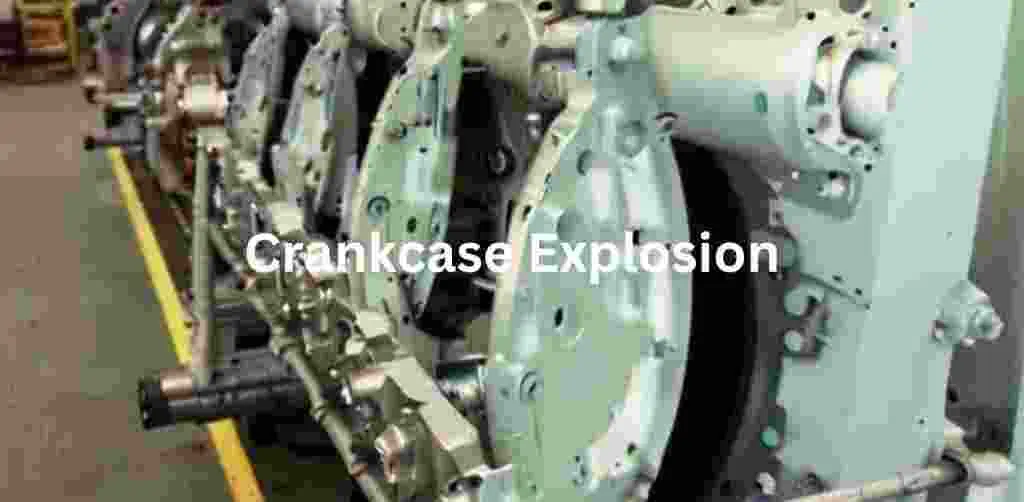Crankcase Explosion
Crankcase explosions in marine engines pose significant risks to vessels and crews. These explosions occur when oil mist or vapor inside the crankcase ignites, causing severe damage to the engine and potential hazards for the crew. In the maritime industry, where engines operate under extreme conditions, preventing such incidents is crucial.
The consequences of a crankcase explosion go beyond engine damage, leading to costly repairs, operational downtime, and legal issues. More importantly, it threatens crew safety, making prevention a priority for maritime operators.
Prevention is essential not just for engine reliability, but for overall maritime safety and efficiency. With the right measures in place, marine engines can run smoothly, minimizing risks and ensuring uninterrupted operations.
This guide will cover seven effective ways to prevent crankcase explosions in marine engines, from proactive maintenance to advanced safety devices like mist detectors, helping operators protect both assets and lives.
Understanding Crankcase Explosions in Marine Engines
What is a Crankcase Explosion?
A crankcase explosion in marine engines happens when oil mist or vapor inside the crankcase ignites, causing rapid engine failure and potential damage to the vessel. These explosions can result in costly repairs, operational delays, and serious safety risks for the crew. Understanding the causes and consequences of crankcase explosions is vital for preventing these dangerous incidents.
Key Causes of Crankcase Explosions in Marine Engines
- Hot Spots
Overheated components, such as worn crankshaft bearings, can cause lubricating oil to vaporize and form an oil mist. If this mist comes into contact with a hot spot, it can ignite and lead to an explosion. - Worn or Damaged Piston Rings
When piston rings become worn or damaged, fuel and air can leak into the crankcase. If this mixture encounters a hot surface, it can ignite, causing a potentially catastrophic explosion. - Blow-by
When combustion gases seep into the crankcase past the piston rings, blow-by happens. These high-pressure gases can ignite the oil mist within the crankcase, resulting in an explosion.
Consequences for Vessel Operations and Crew Safety
Crankcase explosions in marine engines can have devastating effects. The immediate damage to the engine can lead to costly repairs and significant operational downtime. More critically, these explosions can put the safety of the crew at risk, especially in confined spaces where fire and smoke can quickly spread. Additionally, explosions can lead to legal liabilities, impacting the reputation and financial stability of marine operators.
Preventive Measures
To prevent crankcase explosions, operators can take several precautionary steps:
- Install a Breather Pipe: A breather pipe helps prevent pressure buildup, often incorporating a flame trap to prevent fire from spreading.
- Monitor Oil Mist Density: Using a photoelectric sensor, oil mist density can be monitored, with alarms triggered if it exceeds safe levels.
- Evacuate Oil Mist: Fans can be used to create a sub-atmospheric environment to evacuate oil mist, reducing the risk of ignition.
- Slow Down or Stop the Engine: In case of oil mist buildup, slowing down or stopping the engine can help mitigate explosion risks.
7 Top Ways to Prevent Crankcase Explosions in Marine Engines
1. Conduct Routine Maintenance
Regular inspections and servicing are crucial for preventing crankcase explosions. Routine maintenance helps identify potential issues, such as worn components or signs of overheating, before they become critical. It’s essential to address any irregularities promptly to maintain the engine’s reliability and safety.
2. Ensure Proper Crankcase Ventilation
Proper ventilation is key to preventing pressure build-up inside the crankcase. Maintaining adequate airflow helps dissipate heat and prevents the formation of oil mist. A well-ventilated crankcase reduces the risk of ignition and helps maintain engine efficiency.
3. Use Marine-Grade Lubricants
High-quality, marine-grade lubricants are designed to withstand the harsh conditions of marine operations, such as saltwater exposure and high humidity. These lubricants reduce friction, prevent overheating, and lower the risk of vaporization that could lead to an explosion. Regularly monitoring lubricant quality, including flash point analysis, ensures the oil remains effective and safe to use.
4. Install and Monitor Mist Detectors
Mist detectors are critical for early detection of oil mist formation, a leading cause of crankcase explosions. These sensors measure oil mist density and trigger alarms when it exceeds safe levels, allowing operators to take immediate action. Regular testing and calibration of these detectors are essential for their accuracy.
5. Inspect and Maintain Engine Components
Regular inspections of key engine components—such as bearings, pistons, and seals—help detect signs of wear or damage that could contribute to crankcase explosions. Worn-out parts should be replaced promptly to maintain optimal engine performance and safety.
6. Install Flame Arrestors
Flame arrestors are devices designed to prevent the spread of flames inside the engine. By blocking sparks and flames from reaching combustible mixtures in the crankcase, flame arrestors provide an additional layer of protection against explosions. Installing and maintaining these devices is crucial for enhancing engine safety.
7. Train Crew on Emergency Procedures
Training the crew on proper emergency procedures ensures they can respond quickly and effectively in the event of a crankcase explosion or other engine hazards. Crew members should be familiar with shutdown protocols, fire suppression systems, and evacuation procedures to mitigate damage and protect lives.
Lab Testing and Oil Analysis
To ensure the lubricating oil remains safe and effective, it’s important to perform regular lab tests, especially to monitor the flash points of the oil. Flash point testing determines the temperature at which the oil can vaporize and ignite. By analyzing oil samples at specified intervals, operators can detect any potential risks due to oil degradation or contamination, ensuring the engine runs smoothly and safely.
Crankcase Explosion FAQ
Q. What causes a crankcase explosion?
Ans. A crankcase explosion is caused by the combination of heat, oxygen, and fuel.
Q. When does a crankcase explosion typically occur in IC engines?
Ans. Crankcase explosions in IC engines usually start with a mild explosion, followed by a bigger one.
Q. How can you prevent a secondary crankcase explosion?
Ans. Prevent a secondary explosion by resealing the crankcase after it has been over-pressurized.
Q. How can crankcase blowby be reduced?
Ans. Crankcase blowby can be reduced by cleaning carbon deposits and freeing stuck oil rings.
Conclusion
In conclusion, preventing crankcase explosions is crucial for the safety and efficiency of marine engines. By implementing preventive measures such as routine maintenance, proper ventilation, using high-quality lubricants, and installing mist detectors, you can significantly reduce the risk of these dangerous incidents. Prioritizing safety and regular maintenance not only protects your vessel and crew but also ensures smooth, uninterrupted operations.
The time to act is now—adopt these best practices today to keep your marine engines running smoothly and securely. Safeguard your assets, protect your crew, and ensure safe and efficient voyages. Don’t wait for a problem to arise—take proactive steps to prevent crankcase explosions and maintain a safer, more reliable engine.

